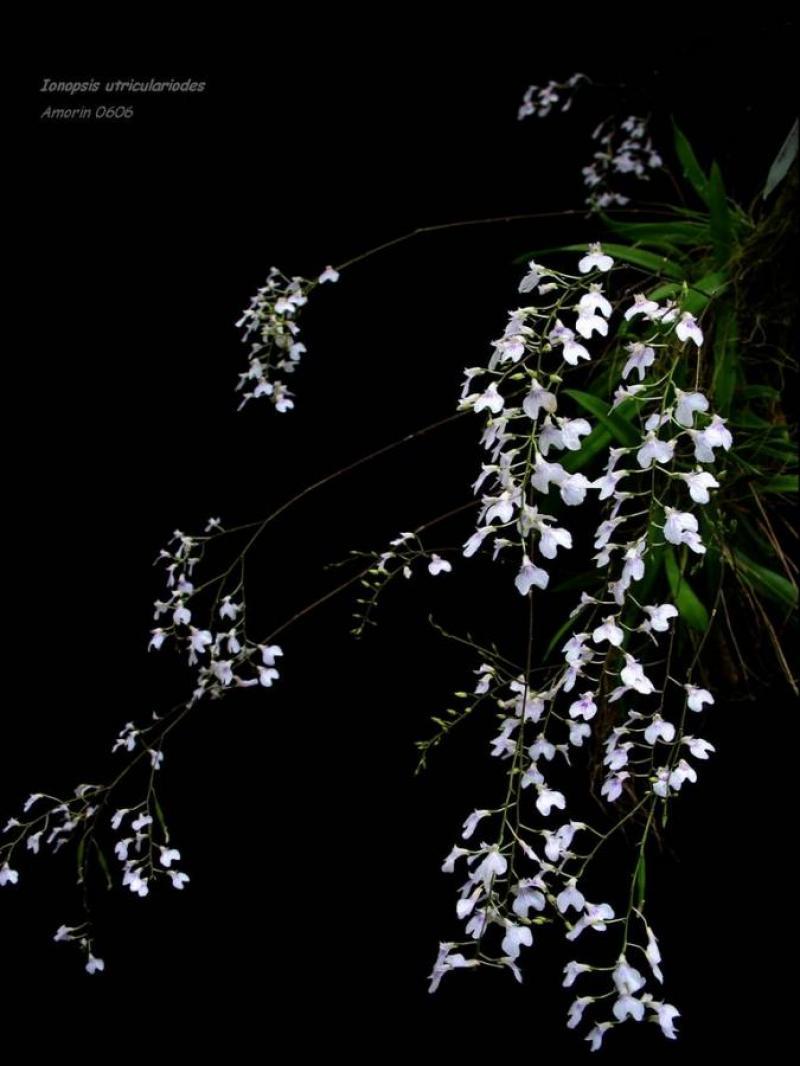Ionopsis utricularioides
Also known as: The Delicate Violet Ionopsis or Scaphyglottis pallidiflora Epidendrum sessei Ionopsis gardneri Ionopsis zonalis Epidendrum crenatum Ionopsis pulchella Ionopsis tenera Ionopsis pallidiflora Ionopsis utricularioides h.v. paniculata Cybelion utriculariae Cybelion pallidiflorum Cybelion tenerum Cybelion pulchellum Ionopsis paniculata Iantha pallidiflora Ionopsis tenera var. violacea Ionopsis utricularioides var. angustifolia Ionopsis utricularioides f. latifolia Ionopsis utricularioides var. parviflora Ionopsis utricularioides f. virginalis Ionopsis utricularioides var. virginalis Ionopsis tenera var. effusa Ionopsis paniculata var. maxima Ionopsis tenera var. tomentosa in the subfamily: Epidendroideae
Native to: Mexico
General Information
The Delicate Violet Ionopsis is a miniature warm to hot growing epiphytic orchid belonging to the sub family Epidendroideae native to Mexico.
Plant Description
Each new growth has a single leathery thick, rigid, lance shaped, oblong shaped leaf that grows to 1.2-17cm long. Pseudobulbs grow to 3cm
Flowers
Numerous short lasting blossoms appear
Substrate(s)
- Coarse
- Charcoal
- Perlite
Care Notes
These orchids like to be kept on the dry side, but may need to be watered daily during warm weather, and prefer a well draining mix or also do well mounted, provided they can be watered regularly.
These are quite a forgiving orchid, there are no special requirements to get this orchid to flower, just good care and consistent conditions. Larger plants may be more fussy and can react poorly to change; a poorly timed repotting, a pest infection or an unusually hot day can set them back for a couple of years. However, even plants that have been treated poorly can thrive, and if they are set back they often recover much stronger then they would otherwise be.
Climate
Grows at low to high elevations. Rainfall ranges from 38mm to 508mm per day, heaviest in September and lightest in March. Humidity ranges from 82% to 90%, highest in January and lowest in April. Temperature ranges from 16C to 28C, highest in May (20C to 28C) and lowest in January (16C to 21C).
Fertiliser
Apply liquid based fertiliser per recommended directions. They can benefit from a high phosphate fertiliser leading up to flowering season, followed by a high nitrogen fertiliser when new growth appears, and a balanced fertiliser in other times. These orchids can also tolerate slow release fertiliser applied 1-2 pellets per cup (250ml) of media.
Use balanced fertiliser during Spring and Summer. Apply fertiliser regularly at half strength year round. Use a high Nitrogen fertiliser during Spring and Summer. Use a high Phosphorous fertiliser during Summer.Potting
These plants are quite forgiving and will do well repotted ever 2-3 years. The mix should be coarse, well draining, and allow space for air to move and for roots to grow.
Alternatively, these plants will also do well mounted to tree fern or cork slabs, or mounted to trees.
Best time for repotting or mounting the orchids is the end of winter when new growths start to appear. Avoid repotting during hot weather,
Use water retentive media such as moss to prevent roots from drying out quickly This plant does very well in baskets or suspended pots This plant does well mounted. Repotting is best done annually and in a pot the same size or only slightly larger than the previous one.




















